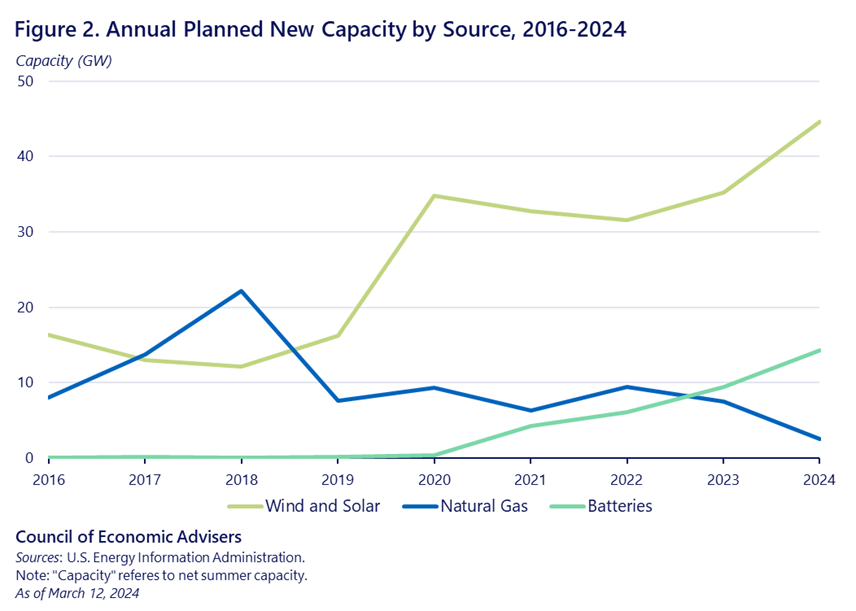The Next Phase of Electricity Decarbonization? Planned Power Capacity is Nearly All Zero-Carbon
For the first time since the mid-20th century, over 95 percent of this year’s planned new electric-generating capacity in the United States is zero-carbon.[1] Natural gas has long been relied on to ensure the nation’s power grids deliver electricity when needed. However, recent trends indicate a shift: Between 2020 and 2024, the share of new capacity burning natural gas fell from 21 percent to 4 percent while the share of new battery storage capacity has skyrocketed, increasing from 1 percent to 23 percent. This stunning growth in battery deployment means that moving forward, utilities will be able to bring online even more renewable energy—such as solar or wind—without relying as much on natural gas.
While there is still plenty of existing fossil fuel capacity across the United States, this increase in new capacity from battery storage is an important milestone toward a fully clean power grid. There has already been significant progress reducing greenhouse gas (GHG) emissions from the U.S. power sector. Over the past two decades, a drop in carbon-intensive coal-fired generation coupled with the rise in less carbon-intensive natural gas[2] and zero-carbon renewable generation has led to a steady decline in power sector GHG emissions (Figure 1).

However, because natural gas use has continued to trend upwards, some have suggested that there is a complementarity between renewables and natural gas that will stall progress on net zero emissions goals. The argument goes: As renewables become more common, so too is the need for electricity that can readily meet variable demand when there is no sun or wind. Because natural gas is dispatchable—that is, it can, unlike sun or wind, be readily switched on or off—it provides a quick supply response that allows utilities to provide power exactly when it is needed. Given this possible complementarity between renewables and natural gas, it is hard to imagine achieving a zero-carbon grid—particularly as electricity demand grows with increased adoption of electric vehicles, heat pumps, data centers, and other technologies.

Recent data, however, suggest a new phase of decarbonization is upon us. The Energy Information Agency reported that for 2024, planned natural gas capacity is at a 25-year low of 2.5 gigawatts (GW), or just 4 percent of total planned capacity. This is down from 21 percent of planned capacity as recently as 2020 (Figure 2). Meanwhile, there is an unprecedented rise in total planned capacity coming from battery storage, up from a mere 1 percent of planned capacity in 2020 to 23 percent (14.3 GW) in 2024. This new battery capacity is occurring while solar and wind capacity continues to grow, with 44.6 GW of planned capacity for 2024, or 71 percent of total. Altogether, combining batteries, renewables, and nuclear, a stunning 96 percent of new electric-generating capacity for 2024 is zero-carbon. And while fossil fuels still account for 60 percent of existing electricity generation, having almost no fossil capacity planned for 2024 represents a significant milestone on the road to a net-zero future.
What is happening here? Just as natural gas generators can ramp down when renewables are available and ramp up when they are not, batteries can charge and discharge. This makes batteries a complement to renewables and a substitute for natural gas. In fact, one version of a net-zero future has renewables both providing power when the sun is out or the wind is blowing and also charging batteries that can discharge power at other times—like charging your phone while talking on it. This is how the power grid can become emissions-free: When the sun is down or the wind is slow, batteries discharge power so that electrons from renewables can supply power at all times.
In the coming years, the installation of batteries that can replace natural gas will likely accelerate. Between 2020 and 2023, utility-scale battery capacity in operation more than tripled. The share of planned battery capacity of total annual planned capacity has increased in nearly every major power grid since 2017, with battery shares exceeding 25 percent in many grids for 2024.
The policies of the Biden-Harris Administration have played an important role. The Inflation Reduction Act (IRA) introduced an investment tax credit for utility-scale battery storage covering up to 50 percent of the developer’s investment. This investment tax credit is part of a broader package of demand- and supply-side policies under the IRA that include subsidies for residential adoption of batteries and investment and production tax credits for domestic manufacturing of batteries, which CEA details in Chapter 6 of this year’s Economic Report of the President. Since the passage of the IRA, domestic manufacturing investments in battery production—for both grid scale and EV batteries—have increased from $2.3 billion to $9.9 billion according to the Clean Investment Monitor. As of 2023:Q4, battery manufacturing investments represented 67 percent of investments in clean technology manufacturing.
These policies will supercharge battery deployment in the coming years, particularly as two ongoing trends continue to increase the demand for batteries. First, increasing electrification of the economy, from EVs to heat pumps, is increasing electricity demand for the first time in over a decade. Second, even without increases in overall electricity demand, there are moments in places such as in California and Texas where excess supply of zero-carbon, zero-marginal cost renewable electricity must be turned away from the grid. This curtailment of renewable energy is expected to grow. Batteries can absorb excess clean power, simultaneously meeting greater electricity demand and enabling accelerated power sector decarbonization.
[1] CEA calculations based on data from Meng (2022). Hydropower, which is zero-carbon, was a large share of new power capacity during the first half of the 20th century. We henceforth use renewables to refer to only wind and solar.
[2] Natural gas is roughly half as carbon-intensive as coal.
